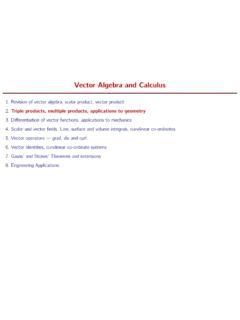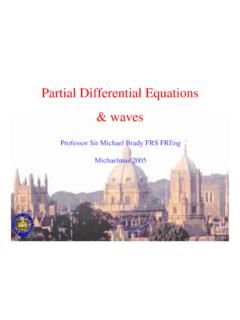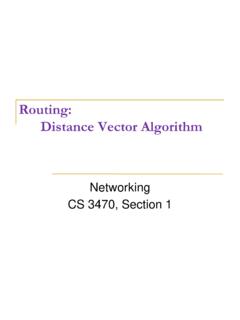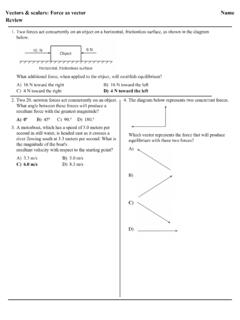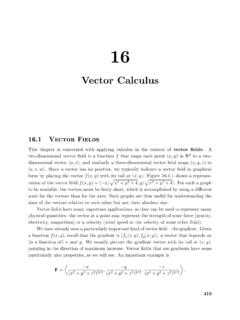Transcription of Vector Algebra and Calculus - University of Oxford
1 Vector Algebra and of Vector Algebra , scalar product, Vector products, multiple products, applications to of Vector functions, applications to and Vector fields. Line, surface and volume integrals, curvilinear operators grad, div and Identities, curvilinear co-ordinate and Stokes Theorems and Applications2. More Algebra & Geometry using VectorsIn which we discuss .. Vector products:Scalar Triple Product, Vector Triple Product, Vector Quadruple Product Geometry of Lines and Planes Solving Vector equations Angular velocity and momentsTriple and multiple Using mixtures of scalar products and Vector products, it is possible to derive triple products between three vectors n-products betweennvectors. Nothing new about these but some have nice geometric interpretations.
2 We will look at the Scalar triple product Vector triple product Vector quadruple productScalar triple producta (b c) Scalar triple product given by the true determinanta (b c) = a1a2a3b1b2b3c1c2c3 Your knowledge of determinants tells you that if you swap one pair of rows of a determinant, sign changes; swap two pairs of rows, its sign stays the same. Hence(i)a (b c) =c (a b) =b (c a) (Cyclic permutation.)(ii)a (b c) = b (a c) and so on. (Anti-cyclic permutation)(iii) The fact thata (b c) = (a b) callows the scalar triple product to be written as [a,b,c].This notation is not very helpful, and we will try to avoid it interpretation of scalar triple The scalar triple product gives the volume of the parallelopiped whose sides are represented by the vectorsa,b, cos c Vector product (a b) hasmagnitude equal to the area of the basedirection perpendicular to the base.
3 Thecomponentofcin this direction is equal to the height of the parallelopipedHence|(a b) c|= volume of parallelopiedLinearly dependent If the scalar triple product of three vectorsa (b c) = 0then the vectors arelinearly b+ cbacn You can see this immediately either using the determinant The determinant would have one row that was a linear combination of the others or geometrically for a 3-dimensional Vector . the parallelopiped would have zero volume if squashed triple producta (b c) (b c) is perpendicular to (b c)but (b c) is perpendicular (b c) must becoplanarwithbandc. a (b c) = b+ cxIn arbitrary directionacbab c( b xxc )(a (b c))1=a2(b c)3 a3(b c)2=a2(b1c2 b2c1) +a3(b1c3 b3c1)= (a2c2+a3c3)b1 (a2b2+a3b3)c1= (a1c1+a2c2+a3c3)b1 (a1b1+a2b2+a3b3)c1= (a c)b1 (a b)c1 Similarly for components 2 and 3: so[a (b c)] = (a c)b (a b)cProjection using Vector triple Books say that the Vector projection of any old vectorvinto a plane withnormal nisvINPLANE= n (v n).
4 The component ofvin the ndirection isv nso I would write the Vector projection asvINPLANE=v (v n) nvnvINPLANE Can we reconcile the two expressions? Subst. n a,v b, n c, into our earlier formulaa (b c) = (a c)b (a b)c n (v n) = ( n n)v ( n v) n=v (v n) n Fantastico! Butv (v n) nis much easier to understand, cheaper to compute! Vector Quadruple Product (a b) (c d) We have just learned that[p (q r)] = (p r)q (p q)r (a b) (c d) = ?? Regardinga bas a single Vector vqp must be a linear combination ofcandd Regardingc das a single Vector vqp must be a linear combination ofaandb. Substituting in carefully (you check ..)(a b) (c d) = [(a b) d]c [(a b) c]d= [(c d) a]b [(c d) b]aVector Quadruple Product Using just the R-H sides of what we just wrote.
5 [(a b) c]d= [(b c) d]a+ [(c a) d]b+ [(a b) d]c Sod=[(b c) d]a+ [(c a) d]b+ [(a b) d]c[(a b) c]= a+ b+ c. Don t remember by Key point is that the projection of a 3D vectord onto a basis set of 3 non-coplanar vectors the quadruple Vector product to express the vectord= [3,2,1] in terms of the vectorsa= [1,2,3],b= [2,3,1]andc= [3,1,2].Answerd=[(b c) d]a+ [(c a) d]b+ [(a b) d]c[(a b) c]So, grinding away at the determinants, we find (a b) c= 18 and (b c) d= 6 (c a) d= 12 and (a b) d= 18(6a 12b 12c)=13( a+ 2b+ 2c)Geometry using vectors: Equation of line passing through pointa1and lying inthe direction of vectorbisr=a+ bPoint r tracesout ^r NB! Only when youmake a unit Vector in the dirn ofbdoes the parameter take on the length units defined bya:r=a+ b For a line defined by two pointsa1anda2r=a1+ (a2 a1) or the unit version.
6 R=a1+ (a2 a1)/|a2 a1|The shortest distance from a point to a Vectorpfromcto ANY line pointrisp=r c=a+ b c= (a c) + bwhich has length squaredp2= (a c)2+ 2+ 2 (a c) b. barcr c Easier to minimizep2rather p2= 0 when = (a c) b. So the minimum length Vector isp= (a c) ((a c) b) surprise! It s the component of (a c)perpendicularto b. We could therefore write using the book formula ..p= b [(a c) b] pmin=| b [(a c) b]|=|(a c) b|.Shortest distance between two straight Shortest distance from point to line is along the perp line shortest distance between two straight lines is along mutual perpendicular. The lines are:r=a+ br=c+ d The unit Vector along the mutual perp is p= b d| b d|.(Yes! Don t forget that b dis NOT a unit Vector .)
7 Ac bQP d The minimum length is therefore the component of (a c) in this directionpmin= (a c) ( b d| b d|) . civil engineersTwo long straight pipes are specified using Cartesianco-ordinates as follows:Pipe A: diameter ; axis through points (2,5,3) and(7,10,8).Pipe B: diameter ; axis through points (0,6,3) and( 12,0,9).Do the pipes need re-aligning to avoid intersection? Example A and B have axes:rA= [2,5,3] + [5,5,5] = [2,5,3] + [1,1,1]/ 3rB= [0,6,3] + [ 12, 6,6] = [0,6,3] + [ 2, 1,1]/ 6(Non-unit) perpendicular to both their axes isp= k1 1 1 2 1 1 = [2, 3,1]The length of the mutual perpendicular is mod(a b) [2, 3,1] 14= [2, 1,0] [2, 3,1] 14= of the radii of the pipes is + = the pipes do not [0,6,3][7,10,8][2,5,3][ 12,0,9]Three ways of describing a plane.
8 Number Point + 2 non-parallel vectorsIfbandcnon-parallel, andais a point on the plane, thenr=a+ b+ cwhere , are scalar to the plane, notNB that these arenecessarily in the planeOThree ways of describing a plane. Number Three pointsPointsa,bandcin the + (b a) + (c a)arcbOVectors (b a) and (c a) are said tospan the ways of describing a plane. Number Unit normalUnit normal to the plane is n, and a pointin the plane isar n=a n=DOan^rNotice that|D|is the perpendicular distance to the plane from the not justD?The shortest distance from a point to a The plane isr n=a n=D The shortest distancedminfrom any point to the plane is along the perpendicular. So, the shortest distance from theoriginto the plane isdmin=|D|=|a n|=|a (b c)||b c|.
9 Now, the shortest distance from pointdto the plane ..?1. Must be along the + nmust be a point on plane3. (d+ n) n=D4. =D d n=| |=|D d n|On^rdSolution of Vector Find the most general vectorxsatisfying a given Vector a+b General Method (assuming 3 dimensions)1. Set up a system ofthree basis vectorsusingtwonon-parallel vectors appearing in the original Vector relation-ship. For examplea,b, (a b)2. Writex= a+ b+ a bwhere , , are scalars to be Substitute expression forxinto the Vector relationship to determine the set of constraints on , , and . Example: Solvex=x a+ 1:Basis vectorsa,band 2: x= a+ b+ a 3:Bungxback into the equation! a+ b+ a b= ( a+ b+ a b) a+b=0+ (b a) + (a b) a+b= (a b)a+ ( a2+ 1)b (a b)Equating coefficients ofa,banda bin the equation gives = (a b) = a2+ 1 = so that =11 +a2 = 11 +a2 =a b1 + finally the solution is the single point:x=11 +a2[(a b)a+b (a b)] Another not all the parameters are determined: and might depend on an arbitrary choice of (see 2A1A sheet).
10 And what happens if there are not two fixed vectors in the expression? a= 1 Usea, introduce an arbitrary vectorb, anda bStep 2: x= a+ b+ a 3:Bungxback into the equation! a2+ b a=K =K a2b aSo, here , ANDbare arbitary ..x= a+K a2b ab+ a bA random comment about solving Vector Suppose you are faced with a+ b=cand you want . What is the fast way of getting rid ofb? Useb b= a b=c b (a b) (a b) = (c b) (a b) =(c b) (a b)(a b) (a b)A random comment about solving Vector a+ b=c An alternative is to construct two simultaneous equations a b+ b2=c b a2+ a b=a cand eliminate =(a b)(b c) (a c)b2(a b)2 a2b2 Compare with previous =(c b) (a b)(a b) (a b)Rotation, angular velocity and A rotation can represented by a Vector whose direction is along the axis of rotation in the senseof a right-handed screw, magnitude is proportional to the size of the The same idea can be extended to the derivatives angular velocity angular acceleration.

